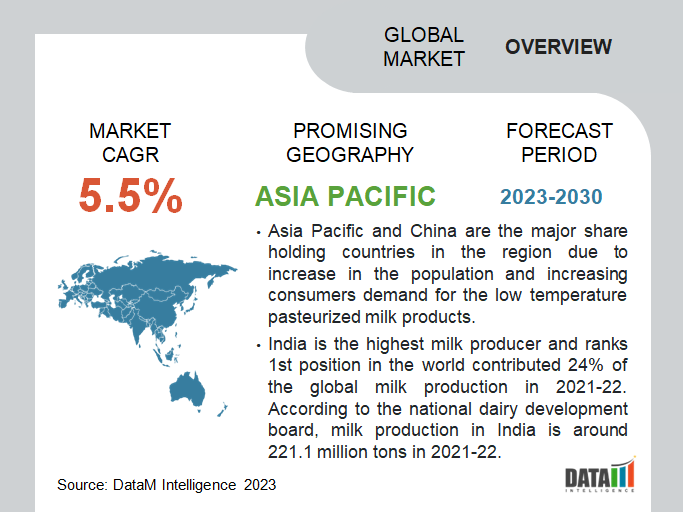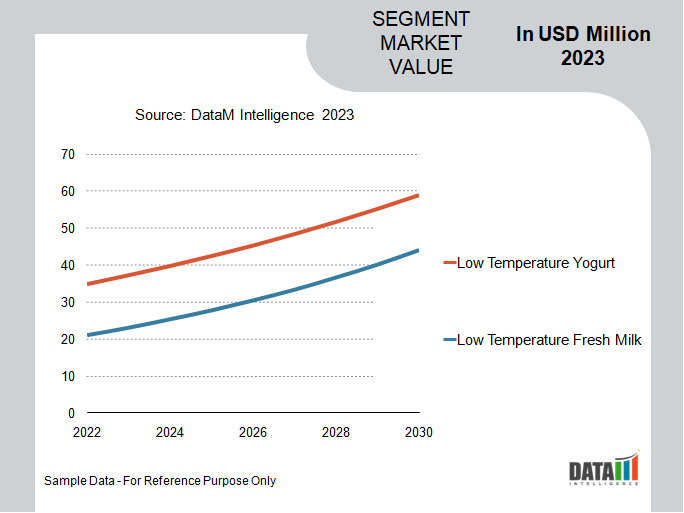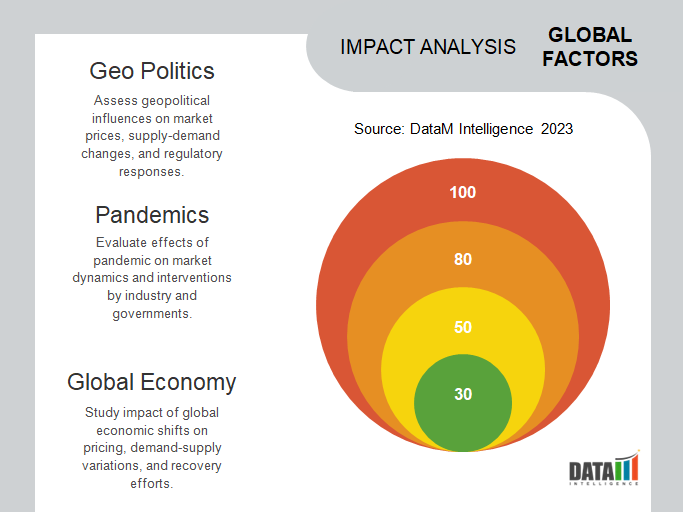Low Temperature Pasteurized Milk Market Size
Global Low Temperature Pasteurized Milk Market reached USD 3.5 billion in 2022 and is expected to reach USD 5 billion by 2030 growing with a CAGR of 4.7% during the forecast period 2024-2031. Gentle pasteurization involves heating the product at a lower temperature and for a longer duration, seeking to strike a balance between milk safety and product quality.
Extended shelf-life milk is favored for its extended shelf life while low-temperature pasteurized milk appeals to those looking for natural and minimally processed milk option. Low-temperature pasteurized milk uses microbial inactivation techniques at lower temperatures to retain enzymes and nutrients compared to high-temperature pasteurization.
Minimal heat treatment and cold pasteurization, applies gentle processing at lower temperatures to ensure food safety while preserving the natural attributes and nutritional qualities of the product. Cold pasteurization, characterized by minimal heat treatment at lower temperatures, aims to preserve the nutritional content and natural integrity of the product by retaining essential nutrients during the processing. Low temperature pasteurized milk helps in the enzyme activity preservation and helps to keep fresh milk taste.

Market Summary
| Metrics | Details |
| CAGR | 4.7% |
| Size Available for Years | 2022-2031 |
| Forecast Period | 2024-2031 |
| Data Availability | Value (US$) |
| Segments Covered | Type, Milk Type, Application and Region |
| Regions Covered | North America, Europe, Asia-Pacific, South America, and Middle East & Africa |
| Fastest Growing Region | Asia Pacific |
| Largest Region | Asia Pacific |
| Report Insights Covered | Competitive Landscape Analysis, Company Profile Analysis, Market Size, Share, Growth, Demand, Recent Developments, Mergers and Acquisitions, New Product Launches, Growth Strategies, Revenue Analysis, Porter’s Analysis, Pricing Analysis, Regulatory Analysis, Supply-Chain Analysis and Other key Insights. |
To Know More Insights - Download Sample
Market Dynamics
Increasing Demand for Healthy Drinks Among Consumers Driving the Growth of the Low Temperature Pasteurized Milk Market
When low temperature pasteurized milk consumed in appropriate quantities, Low Temperature Pasteurized Milk has a high nutritional value. The product has a caloric content of about 60 calories per cubic meter, making it suitable for weight gainers. It contains important vitamins and minerals that promote bone health, such as magnesium, calcium, potassium, and Vitamin A. Growing recognition of the product’s advantages is expected to boost product demand in the next few years.
Furthermore, rising consumer demand for a longer shelf life products and higher quality is expected to boost market growth. Growth is also expected to be supported by the introduction of cost-effective products. Due to its benefits, such as a long shelf life, bulk purchasing behavior and prolonged use of the milk are expected to extend product application scope. The necessity to increase the shelf life and taste furthermore, additional sugar is added will propel the condensed milk market. This makes it a ready to use the product and added in desserts and beverages.
Rising Demand for Functional Beverages is Driving the Market Growth of Low Temperature Pasteurized Milk Market
Consumers are increasingly seeking functional beverages that offer not only taste but also additional health benefits. For instance, according to The Food Institute, in 2022, the global functional beverage market was worth USD 120 billion functional beverages, including low temperature pasteurized milk with nutrients and functional ingredients, align with this health and wellness focus.
Low temperature pasteurized milk products are often enriched with minerals, vitamins, probiotics, antioxidants, omega-3 fatty acids, and other beneficial components. These functional ingredients offer specific health benefits, such as improved digestion, immune support, or enhanced energy levels. As a result, low temperature pasteurized milk becomes an appealing choice for health-conscious consumers. Hence, Consumers' desire for beverages that provide functional benefits beyond basic nutrition fuels the demand for low temperature pasteurized milk with additional nutrients and functional ingredients.
Competition from Alternative Beverages is a Restraining Factor for the Growth of the Low Temperature Pasteurized Milk Market
Consumers have a wide range of beverage options to choose including carbonated soft drinks, fruit juices, energy drinks, plant-based milk alternatives, ready-to-drink coffee and tea, and more. For instance, according to the British Soft Drink Association, in 2022 the total soft drink market size worth 13,938 million liters in the United Kingdom. This abundance of alternatives creates a competitive landscape, where low temperature pasteurized milk must compete for consumer attention and preference.
The availability of diverse beverage options can dilute the market share of low temperature pasteurized milk and limit the growth potential of low temperature pasteurized milk. As a result, low temperature pasteurized milk may face challenges in capturing the attention and loyalty of consumers looking for unique or specific flavor profiles.
Market Segment Analysis
The global low temperature pasteurized milk market is segmented based on type, milk type, application, and region.
Increase in the Demand of Low Temperature Fresh Milks to Improve Processing Efficiency
The global low temperature pasteurized milk market by type has been segmented by low temperature yogurt, and low temperature fresh milk.
In low-temperature pasteurization, milk is heated to 145°F (63°C) for up to 30 minutes or longer. This method is believed to retain more of the milk's natural enzymes, vitamins and beneficial bacteria compared to high-temperature pasteurization mathod so that it has gained popularity among consumers looking for refined and nutrient-dense intact products. Low-temperature pasteurization preserves many natural milk nutrients, such as vitamins and minerals.
Naturally occurring enzymes in milk can be better preserved by low-temperature pasteurization, which can ferment and contribute to overall milk value. According to researchers low-temperature pasteurization gives it a fresher and more natural taste than high-temperature dairy products. Low-temperature pasteurization can effectively preserve beneficial bacteria such as probiotics that can contribute to gut health.

Market Geographical Share
Asia Pacific Region Held the Largest Share in Low Temperature Pasteurized Milk Market.
Asia Pacific and China are the major share holding countries in the region due to increase in the population and increasing consumers demand for the low temperature pasteurized milk products. India is the highest milk producer and ranks 1st position in the world contributed 24% of the global milk production in 2021-22. According to the national dairy development board, milk production in India is around 221.1 million tons in 2021-22. As production of the milk in the region increased demand of the low temperature pasteurized milk increased.
As health and wellness consciousness grew in Asia Pacific, consumers showed greater interest in products considered more natural and highly nutritious. Low-temperature pasteurized milk capable of retaining more nutrients and enzymes that attracted health-conscious consumers. Economic growth and rising disposable incomes in countries such as China, and India countries have led to an increase in consumer spending on premium healthy foods, including specialty dairy products such as low temperature pasteurized milk.

Low Temperature Pasteurized Milk Companies
The major global players include Bright Dairy & Food Co., Ltd., Yili Group, Mengniu, Hartzler Family Dairy, New Hope Dairy, Sanyuan, Meiji, Snow Brand Milk Products, CLASSY.KISS and Yantang.
COVID-19 Impact on Market
The COVID-19 pandemic has had both positive and negative impacts on the low temperature pasteurized milk market. During the pandemic, consumers sought products with longer shelf lives and greater convenience due to lockdowns. This led to increased demand for shelf-stable milk products that could be stored for extended periods. Manufacturers responded by introducing long-life flavored milk options, such as low temperature pasteurized milk processed products, which experienced a surge in sales.
The low temperature pasteurized milk market, like many other industries, experienced disruptions in supply chains due to lockdowns, transportation restrictions, and logistical challenges. These disruptions led to temporary shortages, delayed deliveries, and difficulties in sourcing raw materials. The supply chain disruptions affected both production and distribution, leading to potential challenges in meeting consumer demand.

By Type
- Low Temperature Yogurt
- Low Temperature Fresh Milk
By Milk Type
- Whole Milk
- Low-fat Milk
- Skim Milk
- Cream
By Application
- Online Sales
- Offline Sales
By Region
- North America
- The U.S.
- Canada
- Mexico
- Europe
- Germany
- The U.K.
- France
- Italy
- Spain
- Rest of Europe
- South America
- Brazil
- Argentina
- Rest of South America
- Asia-Pacific
- China
- India
- Japan
- Australia
- Rest of Asia-Pacific
- Middle East and Africa
Key Developments
- On May 18, 2020, Coca Cola, a largest beverage company and Mengniu Group sign contract sign contract for a high-end low-temperature milk project in Wuhe County of Anhui.
- On March 26, 2023, Bandipora launched milk processing plant in India. The processing company provides pasturized milk from the raw milk to consumers.The company also distributed milk products like ghee, butter, cheese, curd etc.
- On August 18, 2022, A tripartite Memorandum of Understanding (MoU) was signed between UT Administration, Ladakh Autonomous Hill Development Council (LAHDC) Leh, and the National Dairy Development Board (NDDB) for dairy development and operationalization of the Milk Pasteurisation Plant at Agling, Leh-Ladakh.
Why Purchase the Report?
- To visualize the global low temperature pasteurized milk market segmentation based on type, milk type, application, and region, as well as understand key commercial assets and players.
- Identify commercial opportunities by analyzing trends and co-development.
- Excel data sheet with numerous data points of low temperature pasteurized milk market-level with all segments.
- PDF report consists of a comprehensive analysis after exhaustive qualitative interviews and an in-depth study.
- Product mapping available as excel consisting of key products of all the major players.
The global low temperature pasteurized milk market report would provide approximately 61 tables, 56 figures and 122 Pages.
Target Audience 2024
- Manufacturers/ Buyers
- Industry Investors/Investment Bankers
- Research Professionals
- Emerging Companies
